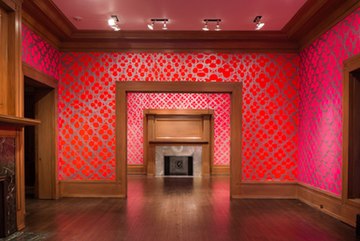Judy Ledgerwood
[6][7][8] Critic John Yau writes, "In Ledgerwood’s paintings the viewer encounters elements of humor, instances of surprise, celebrations of female sexuality, forms of vulgar tactility, and intense and unpredictable combinations of color.
[18][21][1] Ledgerwood emerged in the 1980s during a postmodern crisis of faith in painting's relevance, viability, patriarchal conceits, and commodification by the art market—issues her work addresses through a range of formal and feminist-critical strategies.
[35][30] Largely monochromatic and monumental, they featured nearly uniform oil and encaustic surfaces that hovered between enveloping abstraction and irregular fields barely suggesting landscape (e.g., Composition in Pink, Brown and Violet or Summer Fog, 1992),[36] with occasional insertions of small, flat rectangles that blurred distinctions further.
[26][4] This work employed monochromatic or limited palettes and dissolving grid arrangements of dots, circles or loops, creating complex, flat plays of oscillating color, tone, surface finish and figure-ground based on light conditions, viewer position and retinal effects;[4][8] critics suggest that this indeterminacy introduces elements of extended time, discovery, and "unknowability" into the viewing experience.
[49][26] In 1999, Ledgerwood presented "Cold Days", a body of work specifically created to interact with the changing winter light that would flood its January exhibition at Chicago's Renaissance Society.
[4][8] Bearing titles drawn from Miles Davis's Kind of Blue album, the paintings opened to a wide range of allusions, from pop culture, fashion and design to the glamour and effervescence of champagne bubbles to climate (brittle temperatures, the sheen of ice, winter light, whiteouts) and states of contemplation.
[54][55][56][57][58][25] Michelle Grabner suggested this new work laid "bare Ledgerwood's distrust of elegance and finesse" with its contemporary, doodle-like drawing, loose Pop and quilt-like patterns, Matissean flatness, and funky interior-design palettes.
"[60] He and others noted Ledgerwood's use of irregular white-bordered edges suggesting drooping, bowed tapestries or quilts pinned to walls (e.g., Grandma's Flower Garden, 2006, above)—a reference to traditionally feminine arts—which combined with her overt decorative forms and de-stabilized grids to upend high-modernist conceits of seriousness.
[60][6][25][26] Other critics, such as John Yau and Roberta Smith, have focused on an anarchic element in the work, which foregrounds imperfection and irregularity, process and messiness, humor and female sexuality, and challenges notions of the sublime and beautiful.
[62] Writers suggest that show's off-kilter diamond-patterned grids, unbalanced color interactions, and perspectival shifts posited a modernism reoriented toward fragility and an ungainly, lifelike mortality.




